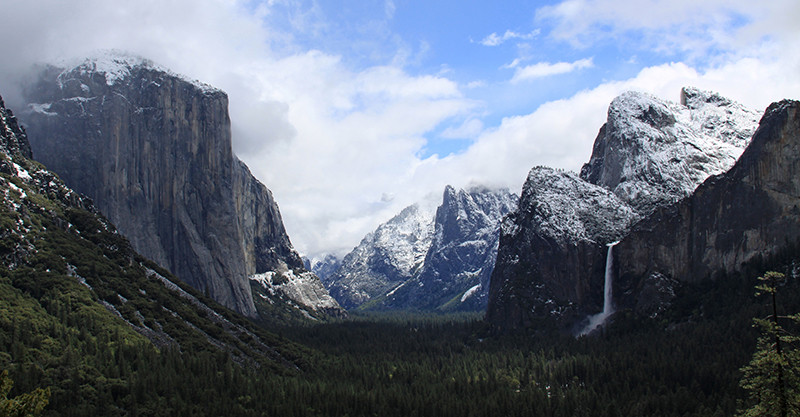
16 Feb Social Media: Maker of Dangerous, Disrespectful Adventures?

Every year, park rangers and search-and-rescue personnel respond to approximately 250 emergency incidents in Yosemite National Park. ©Candice Gaukel Andrews
Recently, on September 2, 2014, the Yosemite National Park Emergency Communications Center received a cell phone call from a hiker on the Yosemite Falls Trail at Columbia Rock, located about a mile from the trailhead. The hiker reported that a 28-year-old woman had slipped and fallen onto a rock and that she was bleeding profusely from several broken teeth. Help was needed.
When a ranger-paramedic arrived on the scene, the hiker who had called for help stated that the injured woman and three others in her group had decided to take an iconic “jumping photo” because they wanted to post it on social media. When they jumped, all four had tucked their legs behind them. However, when the 28-year-old woman landed, she slipped forward on the gravel and slammed her face into a rock.
The ranger-paramedic administered pain medication to the woman and assembled a team to carry her out.
Was getting that picture worth it?
The pursuit of social media stardom

The iconic “jump photo” involves tucking your knees behind you. ©Steve Corey, flickr
Lately, incidents such as this one in Yosemite National Park are becoming more common. Just last year, according to an Outside Magazine article published online on February 24, 2014, a motocross rider fitted a three-foot, pole extension onto his helmet so that he could attach a GoPro camera to it. What the motocross rider didn’t take into account is that mounting a camera on your head can change your center of gravity and throw off your balance. Unfortunately, the rider lost control, hit a tree and wrenched his neck.
Outside Magazine also reports that in another accident, an Australian BASE jumper leaped from a ledge in Moab, Utah, did a flip and released his parachute bridle. He fell to his death when a line wrapped around the chest-cam he was wearing.
It’s telling that all three of these recent accidents happened while people were filming their adventure exploits, with the main purpose of creating a post on websites, such as Facebook, Instagram and YouTube. That’s causing some to wonder: would people be taking the same risks if their activities weren’t being filmed for social media, with the hope of immediate stardom in the offing?
The quest for online notoriety
It seems that not only are more dangerous adventures being attempted, but more disrespectful ones, as well.
Last fall, a series of photos that appeared on the Internet blog Modern Hiker pictured numerous instances of graffiti vandalism in eight national parks: Yosemite, Death Valley and Joshua Tree in California; Colorado National Monument and Rocky Mountain National Park in Colorado; Crater Lake in Oregon; and Canyonlands and Zion in Utah. The National Park Service (NPS) says it is one of the most widespread acts of serial vandalism ever documented in the National Park System.
The perpetrator, Casey Nocket of New York, was identified when Modern Hiker reported to the NPS that the photos were gathered from screen shots taken from Nocket’s Instagram and Tumblr accounts.
Would Nocket still have felt compelled to deface public wild lands if she weren’t active on social media? It’s hard to say, but the fact that she publicly posted photos of her actions means that social media did play a part.
In fact, in a New York Times article dated June 4, 2013, it was noted that some national park personnel say there is reason to believe that the recent spike in graffiti on public lands coincides with the rise of social media and the instant gratification it affords.
The documentarians
In a time before Facebook and Instagram and Tumblr, when I was in my early 20s, I went on an adventure. I drove across the country for the first time, from the Midwest to the West Coast. I didn’t do anything particularly extraordinary on that trip: basically, I just drove.
I do have a few, old, film photographs from that journey, such as one of Nebraska’s flat plains along the Platte River and one of Wyoming’s buttes. There’s one of a pink and purple sky over a gas station somewhere in Utah, where I stopped to fuel up just before sunset. I’m not in many of those photos.
But I wonder how that adventure would change if I repeated it today. Would I feel the pressure to grab the attention of my social media “friends” by doing something crazy and interesting every step of the way and then documenting it for them? I can’t help thinking that today we trade being fully present in our lives for the ability to show them off to others.
Sadly, after the Outside Magazine article on the motocross rider and BASE jumper was published, one commentator on an online biking forum wrote, “at least they got it on video.”
Do you think social media is causing us to undertake more dangerous—and disrespectful—activities in the outdoors?
Here’s to your adventures, in whatever corner of the world you find them,
Candy
Latest posts by Candice Gaukel Andrews (see all)
- 10 Reasons Why a Dose of Fear Is Good for You - December 13, 2017
- Extinction Tourism: Seeing Wild Animals Before They’re Gone - November 8, 2017
- The Travel Cycle’s Four Stages—Plus One - October 18, 2017





No Comments